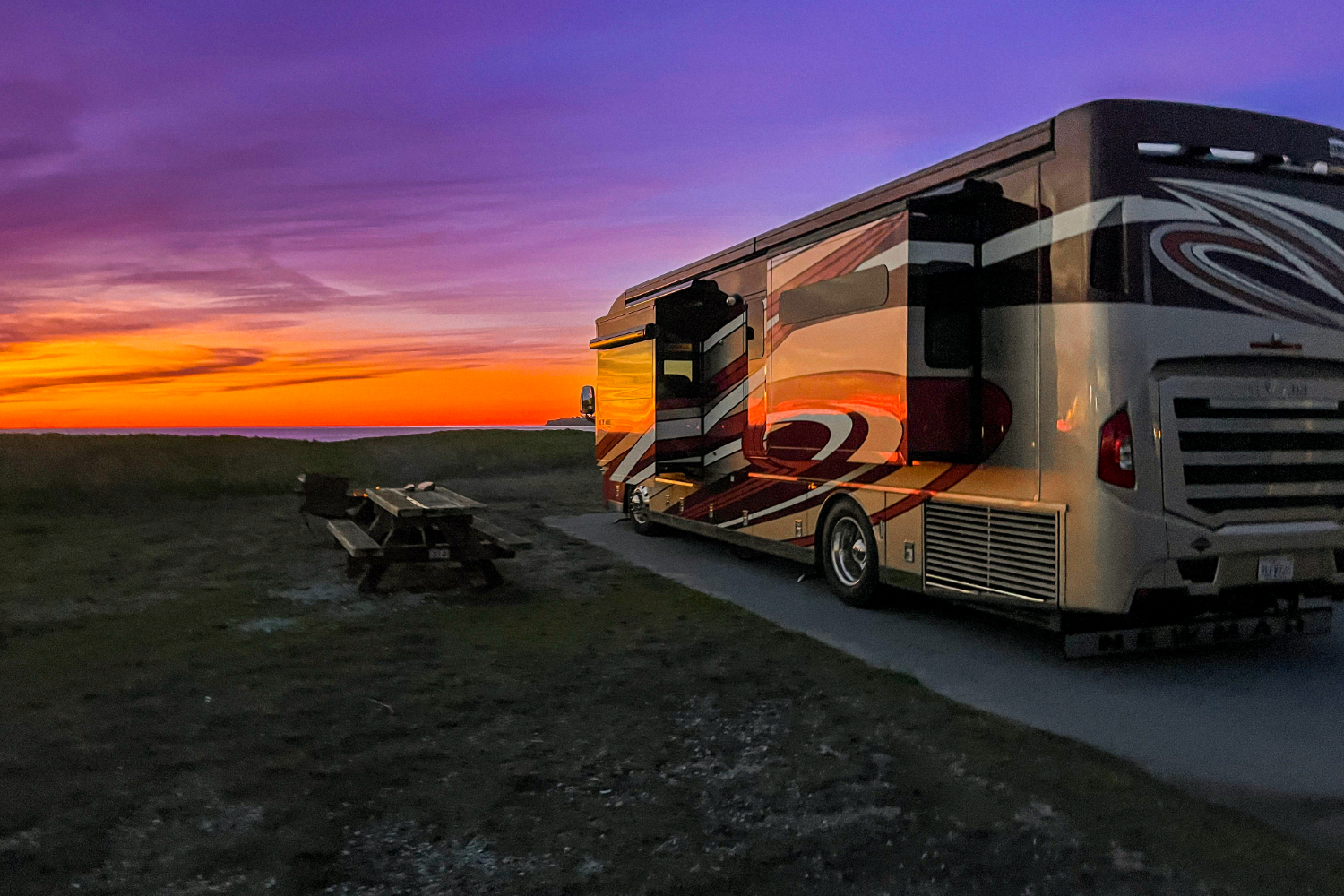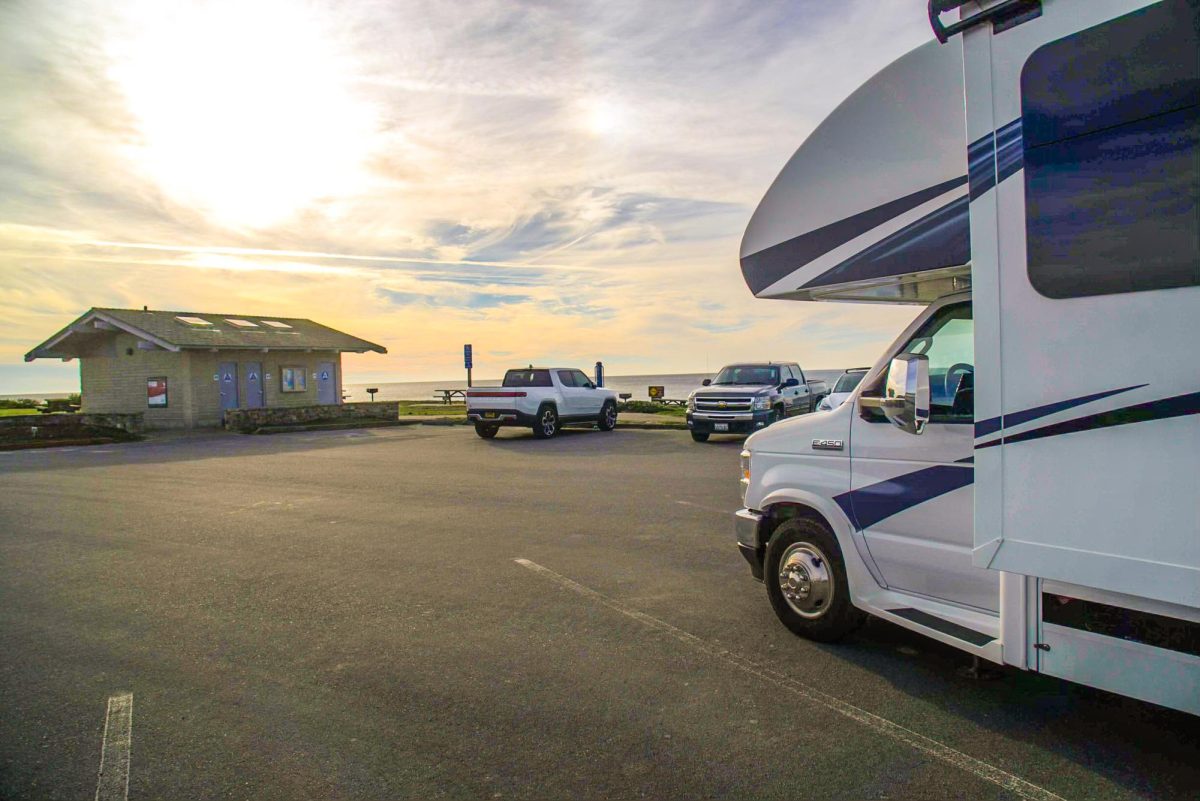“Twenty more feet, Perry!”
The voices of eight frantic teenagers rung out in the middle of a silent South Dakota night.
The bus, named Perry, sputtered as it slowly powered into a Walmart parking lot. It slowly rumbled to a halt, with smoke pouring out of the engine and exhaust. As quickly as it stopped, The Boys With The Bus rushed outside and opened up the engine to take a look.
“Uh oh,” said eight voices at once.
In recent years, an emphasis on living off the grid has been circulating through social media, with hundreds to thousands of people creating content about their experiences living in vans, trucks, recreational vehicles, buses, and more. This increase in perspectives of van life, but these perspectives often don’t tell the full story. There are many hidden sides to living in vans, including mental health struggles, loneliness, and money management.
One of these groups calls themselves The Boys With The Bus. A bunch of high school friends living in Massachusetts came up with the idea as the solution to their senior school project. As a tight-knit friend group from middle school, they often refer to themselves as “The Boys.” Their school, called Milton Academy, requires students to spend a month creating their own projects. Their project, which was to renovate an old school bus and take it on a trip across the country, was the experience of a lifetime.
“It started with ‘Can we rebuild a car?’ And then I was like ‘What if we did a van?’ And then, ‘Oh, what if we just rebuild a bus,’” said Benjamin Siegel, a member of the group.
Once the idea was finalized, they decided to make a bold move, purchasing a $17,000 bus with their own savings before even getting their project approved by the school. Having submitted their pitch without much time to spare, the group sat on the edge of their seats having risked their money and effort.
“We had to choose our project, and it was getting late, so we wrote up a super long proposal to our school and then actually bought the bus before they accepted the proposal,” Siegel said. “We kind of forced their hand to accept our proposal.”
Their goal to touch the Pacific Ocean from their home in Massachusetts was met with many struggles along the way, including the bus breaking twice within 15 hours of each other.
“The first time we broke down was in Gary, Indiana, and we were stuck there for two days. We broke down again in the middle of the night in Sioux Falls, South Dakota,” Siegel said. “After the first break, we went to Chicago for a day trip and came back after the bus was repaired.”
On the other hand, the bus breaking down again at a Walmart in Sioux Falls affected the group much more negatively.
“After the second breakdown, some of the boys were just in shambles, like it really took a toll on us. We slept the night in a Walmart parking lot, which would’ve been fine, but the Walmart chimes kept us up all night” said Sebastian Romero, another member of the group. “At that point, two of The Boys flew home, while the rest of us continued the first leg of the journey to Salt Lake City.”
With their hardships behind their backs, they eventually made it to the Pacific Ocean and completed their goal. Pushing themselves as far as they could, The Boys learned that their limits could be stretched much more than they had originally thought.
“Before van life, I was like, ‘Oh, I’d never be able to live in a tiny town. Oh, I’d never be able to go two weeks without showering. Oh, I’d never be able to not get enough sleep for countless nights,’” Siegel said. “I’ve learned that you can sort of live without these things.”
While The Boys With The Bus experienced van life as kids for fun, Jason and Heather Arbour, nature photographers and professional outdoor travel bloggers, had a different experience with their introduction to van life. While The Boys With the Bus had chosen to risk their savings on a gamble for a school project, the Arbours slowly eased into the lifestyle. Living together in Scotland in 2016, Jason Arbour was taking university classes, and there was a long commute from their house to the university.
“We didn’t want to pay double rent, and we also didn’t want to be separated,” Arbour said. “My wife brought up the idea of getting a camper van and living out of it while I was going to school.”
Starting their van life in Scotland, the Arbours moved back to the United States and switched their blog from a hobby to a professional career
“It was definitely an evolution of the lifestyle,” Arbour said. “It wasn’t sudden; it was just over time.”
From their humble beginnings in Inverness, Scotland, to now having explored almost 40 countries, the Arbours have been working towards their goal of living with intention. When it comes to the benefits of van life, the Arbours enjoy an intentional, lively, stress-free life on the road.
“You don’t have to follow social norms, and you can have a more stress-free life,” Arbour said. “Being in the van is so stress relieving. Being able to just enjoy nature and God’s creation is the best thing for managing stress.”
While the Arbours had been living together in their van, Sam Savat, now a wedding photographer based in Arizona, had a brief experience alone with van life. In 2022, Savat embarked on a two-year-long trip around America in a van that he built himself. Having been a wedding photographer before his van life experience, he had saved enough money to move into a van, which had always been a dream of his.
“I always wanted to do van life. It was probably in 2016 when I was like, ‘This would be a cool thing to do.’ The idea just never left my head. I was like, ‘Yeah, I want to escape the mundane life and live a more exciting life,’” Savat said.
Savat had not originally planned to end his journey at the end of 2023 but did so due to unseen struggles that he faced.
“A bigger reason, and like, they’ll never tell you this in the van life community, but life is very lonely. It can be very hard on your mental health,” Savat said.
Another individual who experienced van life was Jennifer Huang, a tech consultant in Australia. Huang had a very different approach to van life. Instead of committing to a rushed school project or deciding to live permanently, she planned a yearlong trip to North America. In July 2019, Huang, in the U.S. on her temporary work permit, and her partner, Loc To, who was living in Canada at the time, embarked on their road trip across the United States and Canada.
“We’ve always wanted to live a van life. We love the national parks and the outdoors. Having the van and being able to park it wherever you want and stay for however long really appealed to us.”
For two months, they worked on building their own van, which was a struggle as well as a large expense that they had to make before the trip even started.
“The build was probably the hardest part. It took longer than expected,” Huang said. “We had everything we wanted in the van. It was our home for nine months.”
Their trip, originally planned to last from July 2019 to July 2020, was cut short in March 2020 due to the COVID-19 pandemic.
“I think we’re pretty lucky to get through the stuff we wanted to do. But obviously, COVID happened, so we had to cut our trip short,” Huang said. “We probably didn’t get to do a bit that we wanted to do at the end, but yeah, we’re pretty lucky that we got most of it done.”
The economics of van life
While many people might jump ahead and immediately try the van life, an unseen problem manifests itself: money. Even though the van life is a very minimalist lifestyle, it still requires money to get going and stay stable. Living in a stationary home gives people access to jobs and a stable source of funds. When living in a mobile home, working in a classic eight-hour job can be difficult due to not living in a single city. Many van lifers combat the income issue by working remotely, social media, blogs, and sponsorships.
The Arbours make all of their money from their blogs. This allows them to have fully passive income and live life without the worry of money.
“In 2016 when we decided to go into the van life, we decided that it was time to switch from a hobby blog to a professional blog that would make us some money,” Arbour said.
Even though the Arbours generally stick to their blog for income, many people that they’ve met on the road who commit to the van life make their money off of other methods too. Many van lifers have social media followings that make them money. Although social media isn’t the only way that van lifers make money, many do use social media.
“We’re not like big social media people, and we don’t really make any money from social media, but people who are in the van life on social media typically have a larger following than what we do, and they definitely make money from their social media platforms,” Arbour said.
Evan Fu, known online as Stories From a Van, is another van lifer. Fu decided to switch to the lifestyle due to purely financial reasons. Fu decided to move into a van in 2018 while living around the high-rent properties in San Francisco.
“I don’t travel a whole lot. I’m not going on road trips. I live exclusively in the cities, so I treat this lifestyle very differently than, let’s say, like, someone with an Instagram travel centric mindset. I use it primarily, if not exclusively, as a financial tool.
Fu is an example of a self-sufficient van lifer who supports himself through his social media and saves money by budgeting. His biggest reason for living in a van is so that he doesn’t have to pay rent.
“I am currently in the social media space. Social media is certainly a viable source of income. I wouldn’t say it is the most realistic for everyone, but if you have the necessary skill sets and personalities, then it’s absolutely a perfect income source for this lifestyle,” Fu said.
Huang, on the other hand, had no source of active or passive income during her trip. Her trip was much more planned like a vacation, with her only money being the funds that she and To had saved up prior to the trip.
“I was working in the States for three years, and my partner was working in Canada for four years before, so, yeah, we saved up,” Huang said. “We didn’t do any work on the road, so it was just travel. We were lucky enough that, yeah, we were able to get by.”
Just like Huang, The Boys With The Bus saved money before their eventual journey. Initially, their biggest cost was purchasing the bus and outfitting it with supplements that could make it as self-sufficient as possible. Before they even hit the road, The Boys began to gain their massive Instagram following. Once their trip started, they started collaborating and doing sponsorships, which made them their money.
“So we raised $17,000 among the guys, like summer jobs and all that stuff,” Siegel said “After we started the bus project, we got a bunch of brand deals and stuff that has been able to sponsor back that cost and fund the gas and all the money we’ve been using to go across the country.”
Even with the money raised from sponsorships, The Boys have dipped into the negatives, with the two breakdowns in Indiana and South Dakota being the two major factors working against their financial well-being.
“It has made us really consider, ‘Oh, are we gonna continue doing this or just sort of wait for a while until we can figure out the financial situation?’ We felt pretty crappy about the amount of money we used,” Siegel said. “We ended up just fixing the bus and were able to get some more brand deals that were able to cover that cost. Even now, we either break even or are losing money across everything we do.
While traveling around the country, the biggest expense for van lifers is often gas prices, with many gas-run vans averaging 6-10 miles per gallon, and diesel-run vans averaging 7-12 miles per gallon. While diesel vans might seem like a no-brainer, diesel fuel is often more expensive than conventional gasoline, according to a study by National Indoor RV Centers.
“Gas can get super expensive, especially with a van that only gets 15 miles per gallon. If you have a school bus, it’s even more expensive,” Savat said.
While some might associate the creative lifestyle with creative income, many van lifers are finding success in remote corporate jobs. This occupation offers a blend of flexibility and stability, allowing individuals to live life to the fullest while maintaining a traditional career path.
“We’ve met tons of people on the road, and lots of people, corporate jobs, and they work full time on the road. They put in their 40 hours,” Arbour said. “We met a guy who was a corporate banker, and he was working for a company in New York, and we were in Arizona, and so he was waking up at four or five in the morning, and he would be done by one or two in the afternoon. He would have the whole afternoon to hang out and do whatever he wanted.”
The statistics reflect this same trend of a rise in remote work. In recent years due to COVID-19, a 457% increase in remote work job listings was observed on LinkedIn, according to the U.S. Census. Complimenting this leap in remote job listings is an 87% increase in remote work since the pandemic, according to a study conducted by Upwork. A similar correlation can be seen in an increase of van lifers from 1.9 million in 2020 to 2.6 million in 2021, to 3.1 million in 2022.
Fu also brings up that while people get so caught up in the finances of van life, they often miss the central idea of money. Instead of blindly making money to keep stress levels down, Fu sees finances as an obstacle in the way of his main goal, which is the people that he is connected to in San Francisco. Using van life and social media, he overcomes this obstacle in order to reach his goal.
“The finances were the problem. They were a hurdle. I didn’t want to pay rent in the cities I wanted to live in,” Fu said. “There was a city I wanted to live in that I had connections in. I wanted to stay connected, and that’s why I adopted this lifestyle.”
Fu always asks himself why he is making money. He prioritizes the experience and opportunities gained by having money over the actual money and recommends others to do the same.
“I would say that the reason that I think guides you into why you should adopt this lifestyle is not a financial one. The finances, I would say, are almost secondary. The primary one is about how you are going to use this lifestyle to put yourself in a better position to be with people that you love.”
The lessons learned were that one should always be as willing to take risks as one can. Forcing yourself into uncomfortable situations can come with fears, but also great benefits.
“Put yourself in a situation where your later self can’t back out,” Siegel said. “Protect yourself from your future self who might not want to actually follow through or wants to be lazy, because once you buy the bus and you start working on it, you can’t back out.”





